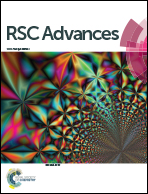Theoretical design of highly energetic poly-nitro cage compounds†
Abstract
In this work, we report on the design and full prediction of four poly-nitro cage compounds, octanitrooctaprismane (ONOP), octanitrooctaazaprismane (ONOAP), tetranitrooctaprismane (TNOP), and tetranitrooctaazaprismane (TNOAP) at the B3LYP/6-31G (d,p) level using density functional theory (DFT). The results show that all compounds possess large positive heats of formation (HOF) and specific enthalpies of combustion (ΔHC). The detonation velocity (D) and pressure (P) are calculated using Kamlet–Jacobs equations, and ONOP, ONOAP, and TNOAP showed a superior performance in comparison to commonly used energetic materials, 1,3,5,7-tetranitro-1,3,5,7-tetrazocane (HMX) and 1,3,5-trinitro-1,3,5-triazinane (RDX). Calculation of the bond dissociation energy (BDE) is carried out and reveals good thermal stabilities for all compounds. In terms of sensitivity, molecules with four nitro groups (TNOP and TNOAP) display lower sensitivity than those with eight nitro groups (ONOP and ONOAP). Importantly, TNOAP outshines other molecules due to its superior energetic properties, compared to those of HMX, and good sensitivity, less than that of 2,4,6,8,10,12-hexanitro-2,4,6,8,10,12-hexaazaisowurtzitane (CL-20) and comparable to that of RDX, so we recommend TNOAP as a promising HEDM candidate.


 Please wait while we load your content...
Please wait while we load your content...